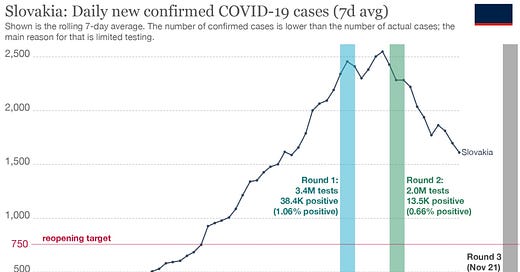Welcome to Plugging the Gap (my email newsletter about Covid-19 and its economics). In case you don’t know me, I’m an economist and professor at the University of Toronto. I have written lots of books including, most recently, on Covid-19. You can follow me on Twitter (@joshgans) or subscribe to this email newsletter here.
Slovakia! I have never been there but I am so grateful for what they have been trying this past month.
As regular readers know, I, like many others including Paul Romer and Michael Mina, have been calling for a large scale attack on the pandemic information gap since March. And the No.1 weapon to deal with that is testing. Since that time, that weapon has become cheaper and more powerful as there are many rapid, antigen tests available that can be deployed at scale. The only missing piece was for someone to try it.
Faced with an explosive increase in cases, the Slovakian government ordered millions of rapid tests and proposed to test their entire population several times of the course of late October through to today. There was an initial pilot in four regions of the country in October. Then the first round was on the weekend of October 31-November 1 with 3.4 million tests. The second came a week later with 2 million further tests. From the Lancet:
For the mass testing, thousands of testing sites are to be set up across the country and everyone over the age of 10 years—approximately 4 million people—will be asked to attend a testing site and take an antigen test. After being tested, people must wait in a separate disinfected room and, around half an hour later, will be given their results.
Here’s the result:
Now a graph can’t prove anything but it sure looks good. Just look at what happened that first weekend. They were recording cases at about 2,500 per day and on that weekend alone they found 38,400 more! That both found cases that would have been missed and brought forward maybe a week of identified cases early who could be isolated. The end result appears to be that they have turned the corner. And there is a further found of testing coming up.
The country has 5 million people although the tests were just for those aged 10 years or older. So they covered most of the population. The tests were not compulsory but there was a lockdown in place and a negative test gave you permission to do more stuff.
Anyone testing positive must remain in strict self-isolation at their home for 10 days, or they can go to a quarantine facility provided by the state. Many shops are being closed and restrictions on movement imposed during the 3-week period of testing with people subject to random spot checks by police. Everyone taking the test will be given a certificate to present if requested. Failure to do so could result in a fine of €1650. The testing is voluntary, but anyone not participating must self-isolate in their homes for 10 days. Breaking this quarantine also carries a fine of €1650. Individuals older than 65 years who spend most of their time at home have been urged not to participate, but the government has said that it will carry out testing of older people in care homes. Testing will also be done in hospitals.
And the good results continue.
The Slovakian government will now ease some of the restrictions as a result of all of this. To be sure, those restrictions now move them towards where Ontario is now. It is hard to judge if that is a good plan or whether it would have been better to push on. There are two many factors that can drive you in either direction. I suspect if this was Europe-wide, there could be a coordinated push to Covid-Zero.
There are more experiments going on. Liverpool will also be one to watch. In Canada, I did an interview and call-back show with CBC radio and my impression is that there was a general appetite for moving to a testing economy throughout Ontario.





